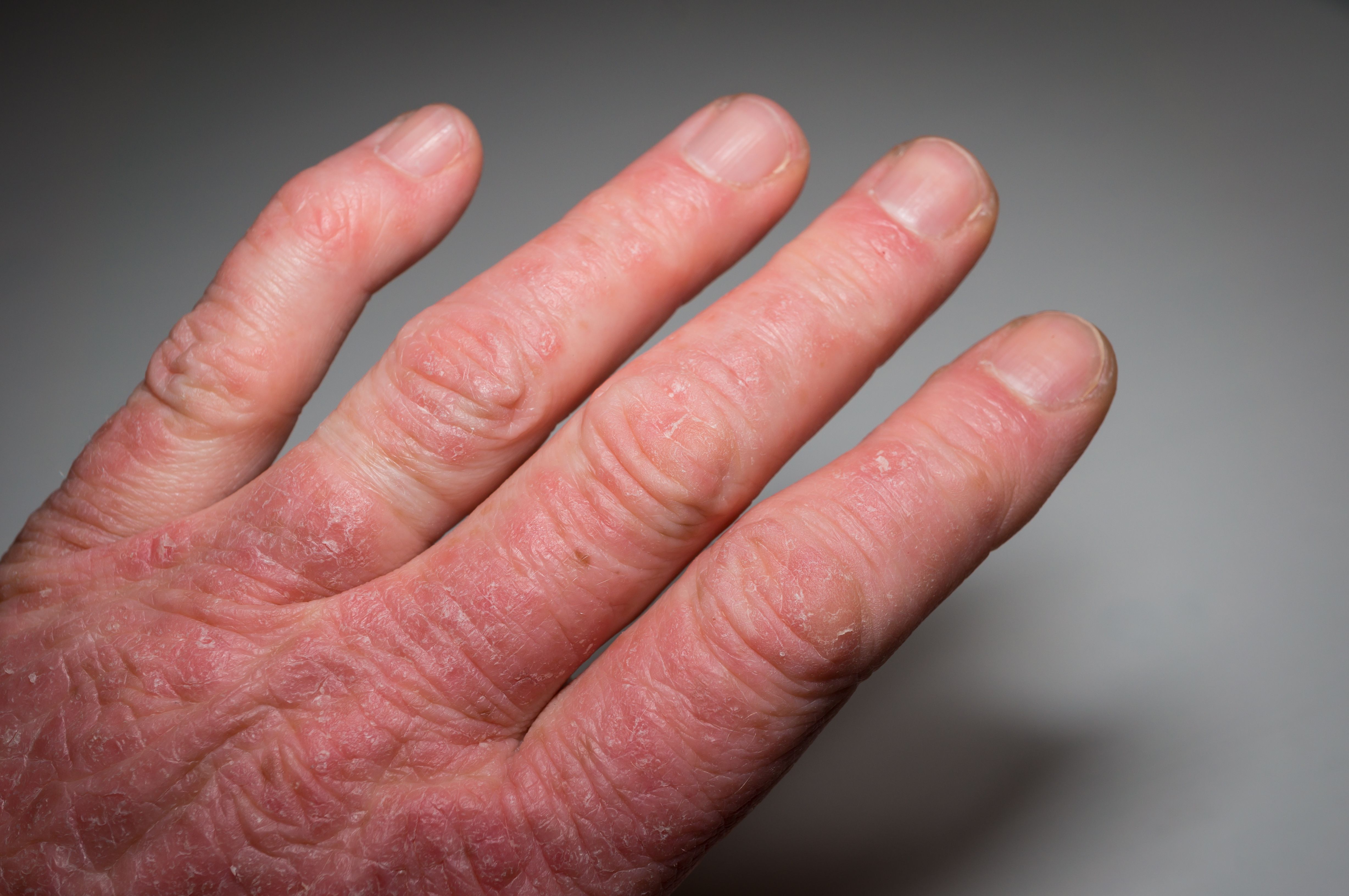- Case-Based Roundtable
- General Dermatology
- Eczema
- Chronic Hand Eczema
- Alopecia
- Aesthetics
- Vitiligo
- COVID-19
- Actinic Keratosis
- Precision Medicine and Biologics
- Rare Disease
- Wound Care
- Rosacea
- Psoriasis
- Psoriatic Arthritis
- Atopic Dermatitis
- Melasma
- NP and PA
- Skin Cancer
- Hidradenitis Suppurativa
- Drug Watch
- Pigmentary Disorders
- Acne
- Pediatric Dermatology
- Practice Management
- Prurigo Nodularis
- Buy-and-Bill
Article
Brepocitinib More Efficacious Than Placebo in Long-Term Psoriatic Arthritis Care
Author(s):
The JAK inhibitor demonstrated promising efficacy and safety.
In a recent study1, tyrosine kinase 2 (TYK2)/janus kinase 1 (JAK1) inhibitor brepocitinib was significantly more efficacious in reducing signs and symptoms of psoriatic arthritis (PsA) than a placebo.
Iri-s/AdobeStock

Researchers sought to evaluate the oral drug’s safety, efficacy, and dose-response in patients with the condition over a long-term period, citing its current in-development role in treating immunological diseases, including prior research evaluating its use in treating dermatomyositis, lupus, ulcerative colitis, alopecia areata, and hidradenitis suppurativa. Furthermore, they noted prior phase 2a study research demonstrating the drug’s involvement in significantly reducing Psoriasis Area and Severity Index (PASI) scores in patients with plaque psoriasis.
The phase 2b study, which was dose-ranging, parallel-treatment group, placebo-controlled, and randomized in nature, involved patient participation across 11 European countries. Participants (n=218) were required to be ages 18 to 75 years old, fulfill the classification criteria for PsA, and have a PsA diagnosis for equal to or greater than 6 months prior to inclusion. Additionally, they were expected to meet the following inclusion criteria:
- 3 or more swollen joints at both the screening stage and baseline
- 3 or more tender or painful joints, notable amid motion
- Active PsA regardless of treatment history or present use of non-steroidal anti-inflammatory drugs (NSAIDs) for at least 4 weeks or intolerance
- Active psoriasis at both the screening stage and baseline
- Conventional synthetic disease modifying antirheumatic drug (csDMARD) treatment of at least 3 months or intolerance
- And/or negative test results for rheumatoid factor and cyclic citrullinated peptide antibodies
Patients were excluded from participation if they were breastfeeding; presented with critical laboratory abnormalities; electrocardiogram abnormalities indicative of an underlying heart disease; had a history of any autoimmune rheumatic disease other than PsA, any lymphoproliferative disorder, chronic or recurrent infection, disseminated herpes infection or a recurrent localized dermatomal herpes zoster, infection requiring hospitalization within 6 months of baseline, or pulmonary embolism or recurrent deep vein thrombosis; had non-plaque psoriasis, were pregnant, or demonstrated risk factors for torsade de pointes.
Patients underwent an up to 5-week screening period following by treatment group randomization. Participants were randomly assigned to 1 of 4 groups: brepocitinib 10 mg, brepocitinib 30 mg, brepocitinib 60 mg, or a placebo. During phase 1 of the 52-week double-blind treatment period, the placebo-controlled phase, participants took their assigned dosage from day 1 to week 16.
At week 16, participants receiving 10 mg brepocitinib or the placebo were advanced to a different dosage group–either the 30 mg or 60 mg brepocitinib groups. This was known as the extended active treatment phase, which lasted from week 17 to week 52. Afterwards, participants underwent a 4-week safety follow-up period.
Researchers defined sufficient progress as a predefined proportion of participants achieving:
- American College of Rheumatology (ACR) scale score of ACR20/50/70
- Dactylitis Severity Score (DSS) change from baseline
- Leeds Enthesitis Index (LEI)
- PASI75/90
- Psoriatic Arthritis Disease Activity Score (PANDAS) change from baseline
- Spondyloarthritis Research Consortium of Canada (SPARCC) Enthesitis Index
- And more
Throughout the study, researchers used the above scales to determine efficacy, while also recording data related to treatment-emergent adverse events (TEAEs), study adverse events (SAEs), serious infections, laboratory abnormalities, electrocardiogram findings, and changes in vital signs. In total, 50 participants withdrew from the study or were excluded as a result of AEs or independent withdrawal.
At week 16, 43.3% of participants in the placebo group achieved ACR20, whereas 64.5%, 66.7%, and 74.6% in the brepocitinib 10 mg, 30 mg, and 60 mg groups, respectively, with higher proportions of patients in the brepocitinib 30 mg and 60 mg groups achieving that metric. These higher proportions were also consistent in the brepocitinib 30 mg and 60 mg groups against the placebo with respect to achievements of PASI75/90, ACR50, and baseline change in Health Assessment Questionnaire – Disability Index (HAQ-DI). Achievement rates of ACR70, PASDAS, and Minimal Disease Activity (MDA) were also higher among all brepocitinib groups when compared to the placebo.
Participants in the higher brepocitinib dosage groups also more frequently experienced resolutions or greater numerical improvements in enthesitis and dactylitis. In all brepocitinib groups, participants reported improvements in arthritis pain, fatigue, and acute 36-item Short Form Health Survey Version 2 Physical Component Summary (SF-36 PCS) score.
11 TEAEs and SAEs were reported during weeks 16 and 52 of the study, including coronavirus infection, pneumonia, varicella, herpes zoster/varicella, anogenital warts, basal cell carcinoma, and uterine leiomyoma.
Study limitations, as noted by investigators, included restricted geographical location and ethnic/racial makeup containing predominately white participants.
“TYK2/JAK1 inhibition with brepocitinib 30 and 60 mg QD significantly improved the signs and symptoms of PsA,” study authors wrote. “These clinical benefits across multiple domains of PsA disease activity were observed over 16 weeks, with sustained or further improvements in disease measures out to week 52. Overall, the safety profile of brepocitinib was consistent with that previously observed in other brepocitinib clinical trials and with that of approved JAKis, and no new safety signals were identified.”
Reference
- Mease P, Helliwell P, Silwinska‐Stanczyk P, et al. Efficacy and safety of tyrosine kinase 2/janus kinase 1 inhibitor brepocitinib for active psoriatic arthritis: A phase iib randomized controlled trial. Arthritis Rheumatol. Published online May 17, 2023. doi:10.1002/art.42519






